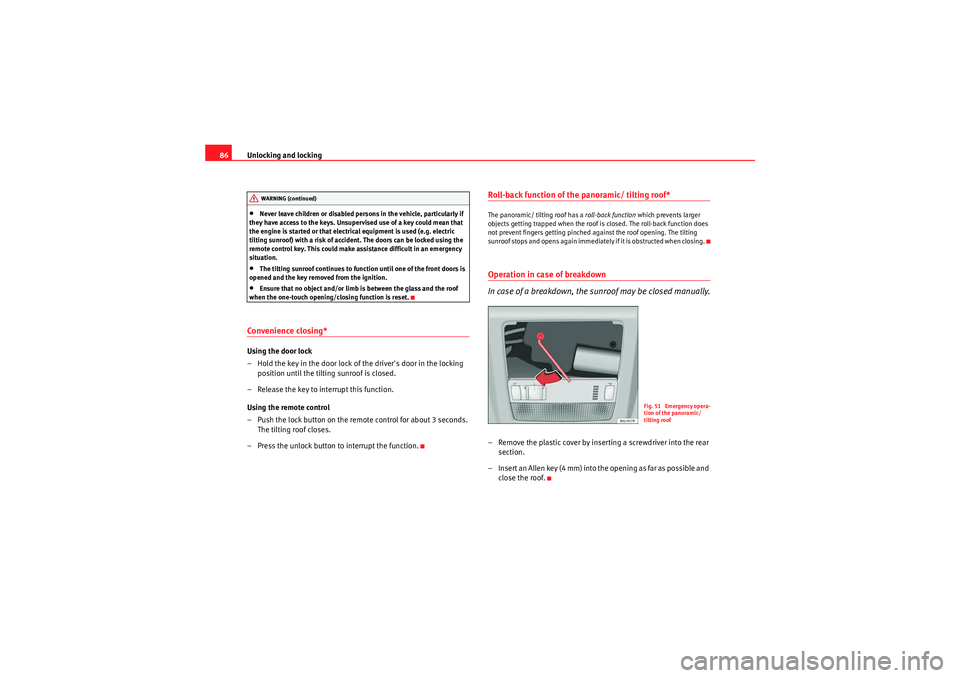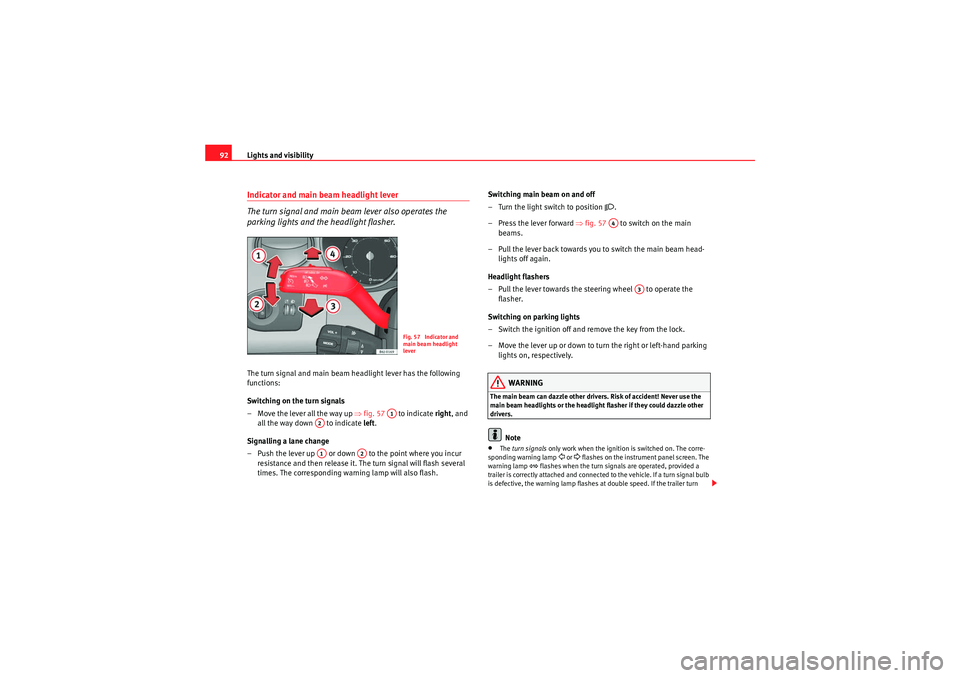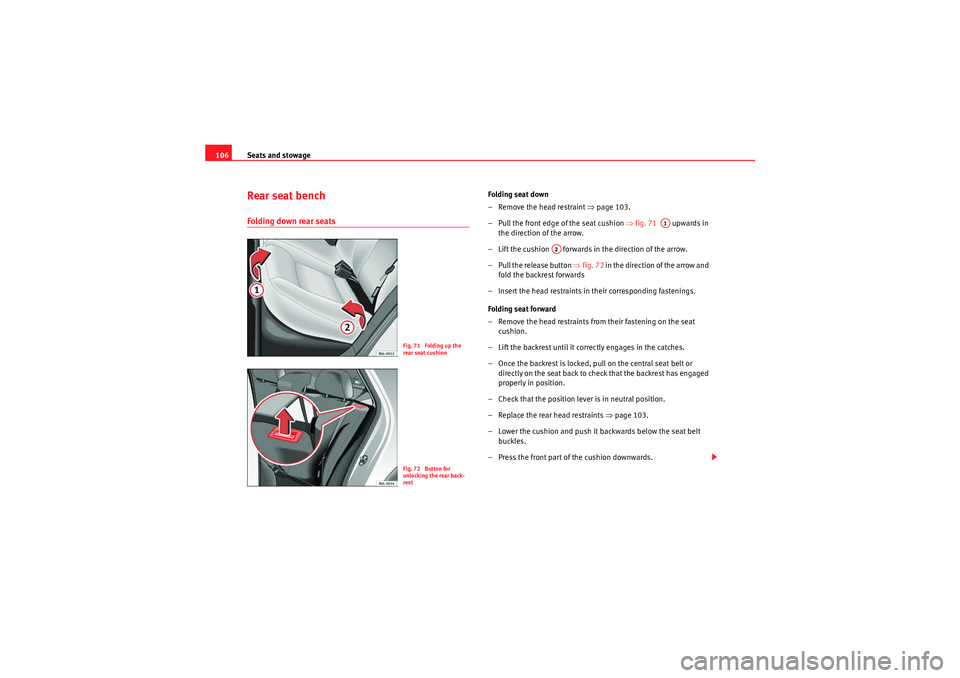2009 Seat Ibiza 5D lock
[x] Cancel search: lockPage 87 of 257

Unlocking and locking85
Safety First
Controls and equipment
Practical tips
Technical Data
Panoramic tilting roof*Opening and closing the sliding/tilting roof
The panoramic/tilting roof is opened and closed by using the
switch when the ignition is switched on.Closing the panoramic/tilting sunroof
– Press and hold button ⇒fig. 50 ⇒ , the roof starts to
close until the button is released.
Opening the panoramic/tilting sunroof
– Press and hold down button . The roof starts opening until the button is released. Automatic closing of the panoramic/tilting sunroof
– Press button once only; the roof starts closing automatically
until it is completely closed.
Automatic opening of the panoramic/ tilting sunroof
– Press button once only. The roof starts opening automatically until it is completely open.
Restoring one-touch opening and closing
– Close the roof manually until it is completely closed. Release the button
– Press the closing button again, keeping it pressed down, until a
complete opening and closing cycle has taken place.
Always close the panoramic/ tilting roof fully if you park the vehicle or leave
it unattended ⇒.
The tilting roof can be operated for up to about ten minutes after the ignition
has been switched off, provided the driver door and the front passenger door
are not open.
Sunroof blind
The sunroof blind is opened and closed manually (independently of the
sliding/ tilting roof).
WARNING
•Incorrect use of the tilting roof can result in injury.•Never close the tilting sunroof without observing and ensuring it is
clear to do, otherwise this may cause serious injury to you and others.
Make sure that no one is in the path of the tilting roof.•Always take the vehicle key with you when you leave the vehicle.
Fig. 50 Panoramic/tilting
sunroof
AB
AA
ABAA
Ibiza_EN.book Seite 85 Montag, 14. September 2009 6:19 18
Page 88 of 257

Unlocking and locking
86•Never leave children or disabled persons in the vehicle, particularly if
they have access to the keys. Unsupervised use of a key could mean that
the engine is started or that electrical equipment is used (e.g. electric
tilting sunroof) with a risk of accident. The doors can be locked using the
remote control key. This could make assistance difficult in an emergency
situation.•The tilting sunroof continues to function until one of the front doors is
opened and the key removed from the ignition.•Ensure that no object and/or limb is between the glass and the roof
when the one-touch opening/closing function is reset.
Convenience closing*Using the door lock
– Hold the key in the door lock of the driver's door in the locking position until the tilting sunroof is closed.
– Release the key to interrupt this function.
Using the remote control
– Push the lock button on the remote control for about 3 seconds. The tilting roof closes.
– Press the unlock button to interrupt the function.
Roll-back function of the panoramic/ tilting roof*The panoramic/ tilting roof has a roll-back function which prevents larger
objects getting trapped when the roof is closed. The roll-back function does
not prevent fingers getting pinched against the roof opening. The tilting
sunroof stops and opens again immediately if it is obstructed when closing.Operation in case of breakdown
In case of a breakdown, the sunroof may be closed manually.– Remove the plastic cover by inserting a screwdriver into the rear section.
– Insert an Allen key (4 mm) into the opening as far as possible and close the roof.
WARNING (continued)
Fig. 51 Emergency opera-
tion of the panoramic/
tilting roof
Ibiza_EN.book Seite 86 Montag, 14. September 2009 6:19 18
Page 90 of 257

Lights and visibility
88•If the lights are left on after the key has been taken out of the ignition lock,
a buzzer will sound while the driver door remains open. This is a reminder to
switch the lights off.•The rear fog light is so bright that it can dazzle drivers behind you. You
should use the rear fog light only when visibility is very poor.•The use of the lighting described here is subject to the relevant statutory
requirements.Instrument and switch lighting / Headlight range controlInstrument and switch lighting
When the headlights are switched on, the brightness of the instruments and
switch lighting can be regulated to suit your requirements by turning the
thumb wheel ⇒fig. 53 .
Those vehicles fitted with xenon gas discharge headlights are fitted with an
automatic headlight range system. Headlight range control
By using the electrical headlight range control, you can adjust the head-
light range to the load level that is being carried in the vehicle. This way, it is
possible to avoid dazzling oncoming traffic more than necessary. At the same
time, by using the correct headlight settings, the driver has the best possible
lighting for the road ahead.
The headlights can only be adjusted when the dipped beam is switched on.
To lower the beam, turn the thumb wheel down from the basic setting
0.
Dynamic headlight range control
Ve hi cle s wi th gas discharge lamps (xenon lamps) are equipped with dynamic
headlight range control . When you switch on the lights, their range regulates
itself according to the vehicle load.
Vehicles with gas discharge lamps do not have headlight range control.
Daytime running lights*
Daylight driving lights light up automatically when the igni-
tion is switched on (only with AFS headlamps)Daylight driving lights switch off automatically when the street lighting
comes on.
Note
See legal requirements for each country.
Fig. 53 Dash panel: regu-
lation for instrument and
switch illumination and
headlight range control
A1
A1
A2
A2A2
Ibiza_EN.book Seite 88 Montag, 14. September 2009 6:19 18
Page 94 of 257

Lights and visibility
92Indicator and main beam headlight lever
The turn signal and main beam lever also operates the
parking lights and the headlight flasher.The turn signal and main beam headlight lever has the following
functions:
Switching on the turn signals
– Move the lever all the way up ⇒fig. 57 to indicate right , and
all the way down to indicate left .
Signalling a lane change
– Push the lever up or down to the point where you incur resistance and then release it. The turn signal will flash several
times. The corresponding warning lamp will also flash. Switching main beam on and off
– Turn the light switch to position
.
–Press the lever forward ⇒fig. 57 to switch on the main
beams.
– Pull the lever back towards you to switch the main beam head- lights off again.
Headlight flashers
– Pull the lever towards the steering wheel to operate the flasher.
Switching on parking lights
– Switch the ignition off and remove the key from the lock.
– Move the lever up or down to turn the right or left-hand parking lights on, respectively.
WARNING
The main beam can dazzle other drivers. Risk of accident! Never use the
main beam headlights or the headlight flasher if they could dazzle other
drivers.
Note
• The turn signals only work when the ignition is switched on. The corre-
sponding warning lamp
or flashes on the instrument panel screen. The
warning lamp
flashes when the turn signals are operated, provided a
trailer is correctly attached and connected to the vehicle. If a turn signal bulb
is defective, the warning lamp flashes at double speed. If the trailer turn
Fig. 57 Indicator and
main beam headlight
lever
A1
A2A1
A2
A4
A3
Ibiza_EN.book Seite 92 Montag, 14. September 2009 6:19 18
Page 95 of 257

Lights and visibility93
Safety First
Controls and equipment
Practical tips
Technical Data
signal bulbs are damaged, warning lamp
does not light up. Change the
bulb.
•The main beam headlights can only be switched on if the dipped beam
headlights are already on. The warning lamp
then comes on in the combi-
instrument.
•The headlight flasher comes on for as long as you pull the lever – even if
no other lights are switched on. The warning lamp
then comes on in the
combi-instrument.
•When the parking lights are switched on, the headlight and the rear light
on the corresponding side of the vehicle light up. The parking lights will only
work if the key is removed from the ignition. If the lights are switched on, a
buzzer gives an audible warning while the driver door is open.•If the turn signal lever is left on after the key has been taken out of the
ignition lock, an acoustic signal sounds when the driver door is opened. This
is a reminder to switch off the turn signal, unless of course you wish to leave
the parking light on.
Interior lightsFront interior light The switch ⇒fig. 58 is used to select the following positions:
Courtesy light position
Sliding switch in central position The interior lights are automatically
switched on when the vehicle is unlocked or the key removed from the igni-
tion lock And turn off approx. 20 seconds after closing the doors. The interior
lights are switched off when the vehicle is locked or when the ignition is
switched on.
Interior light switched on
Move the knob to the position
.
Interior light switched off O
Move the knob to position O ⇒fig. 58.
Fig. 58 Interior roof trim:
front interior lights
AA
Ibiza_EN.book Seite 93 Montag, 14. September 2009 6:19 18
Page 108 of 257

Seats and stowage
106Rear seat benchFolding down rear seats
Folding seat down
– Remove the head restraint ⇒page 103.
– Pull the front edge of the seat cushion ⇒ fig. 71 upwards in
the direction of the arrow.
– Lift the cushion forwards in the direction of the arrow.
– Pull the release button ⇒fig. 72 in the direction of the arrow and
fold the backrest forwards
– Insert the head restraints in their corresponding fastenings.
Folding seat forward
– Remove the head restraints from their fastening on the seat cushion.
– Lift the backrest until it correctly engages in the catches.
– Once the backrest is locked, pull on the central seat belt or directly on the seat back to check that the backrest has engaged
properly in position.
– Check that the position lever is in neutral position.
–Replace the rear head restraints ⇒page 103.
– Lower the cushion and push it backwards below the seat belt buckles.
– Press the front part of the cushion downwards.
Fig. 71 Folding up the
rear seat cushionFig. 72 Button for
unlocking the rear back-
rest
A1
A2
Ibiza_EN.book Seite 106 Montag, 14. September 2009 6:19 18
Page 119 of 257

Heating, Ventilation and Air conditioning117
Safety First
Controls and equipment
Practical tips
Technical Data
•In air recirculation mode, no cold air from the outside enters the vehicle
interior. The windows can quickly fog over if the heating is switched off.
Therefore, never leave the air recirculation mode switched on for a long
time (risk of accident).Note
•Please consider the general notes ⇒ page 125.Vehicle ventilation or heatingVentilating the passenger compartment
– Turn the temperature selector ⇒fig. 88 anti-clockwise.
– Turn blower switch to any of the head settings 1-4. – Set the airflow to the desired
direction using air distribution
control .
– Open the relevant air outlets.
Interior heating
– Turn the temperature selector ⇒fig. 88 clockwise to select
the desired temperature.
– Turn blower switch to any of the head settings 1-4.
– Set the airflow to the desired direction using air distribution
control .
– Open the relevant air outlets.
Defrosting the windscreen
– Turn the temperature selector ⇒fig. 88 clockwise to reach
the maximum temperature.
– Turn the blower switch to setting 4.
– Turn air distribution control to
.
–Close outlet .
– Open and turn outlet towards side windows
Keeping the windscreen and the side windows demisted
– Turn the temperature selector ⇒fig. 88 to the heating zone.
– Turn blower switch to any of the head settings 2-3.
– Turn air distribution control to .
WARNING (continued)
Fig. 88 On the dash
panel there are the
heating controls
AA
AB
AC
AA
AB
AC
AA
AB
A3
A4
AA
AB
Ibiza_EN.book Seite 117 Montag, 14. September 2009 6:19 18
Page 129 of 257

Driving127
Safety First
Controls and equipment
Practical tips
Technical Data
DrivingAddressAdjusting the steering wheel position
The height and reach of the steering wheel can be freely
adjusted to suit the driver.– Adjust the driver seat to the correct position.
–Push the lever ⇒fig. 93 under the steeri ng column down ⇒.
– Adjust the steering wheel until the correct position is set ⇒fig. 93.
– Then push the lever up again firmly ⇒.
WARNING
•Incorrect use of the steering column adjustment function and an incor-
rect seating position can result in serious injury.•To avoid accidents, the steering column should be adjusted only when
the vehicle is stationary.•Adjust the driver's seat or steering wheel so that there is a distance of
at least 25 cm between the steering wheel and your rib cage ⇒fig. 93. If
you fail to observe the minimum distance, the airbag will not protect you.
Risk of fatal injury.•If your physical constitution does not allow you to maintain the
minimum distance of 25 cm, contact an Authorised Service Centre. The
Authorised Service Centre will help you to decide if special specific modifi-
cations are necessary.•If you adjust the steering wheel so that it points towards your face, the
driver airbag will not protect you properly in the event of an accident. Make
sure that the steering wheel points towards your chest.•When driving, always hold the steering wheel with both hands on the
outside of the ring at the 9 o'clock and 3 o'clock positions. Never hold the
steering wheel at the 12 o'clock position, or in any other manner (e.g. in
the centre of the steering wheel, or on the inside of the rim). In such cases,
you could receive severe injuries to the arms, hands and head.
Fig. 93 Steering column
height adjustment
Ibiza_EN.book Seite 127 Montag, 14. September 2009 6:19 18